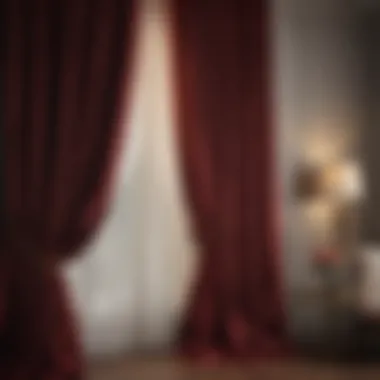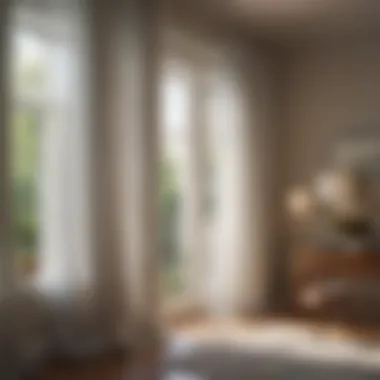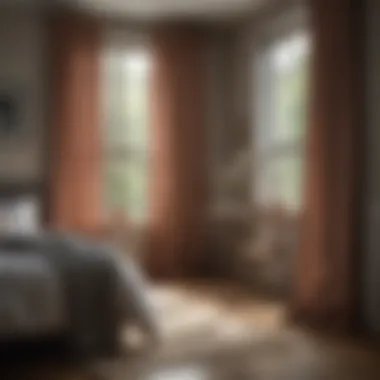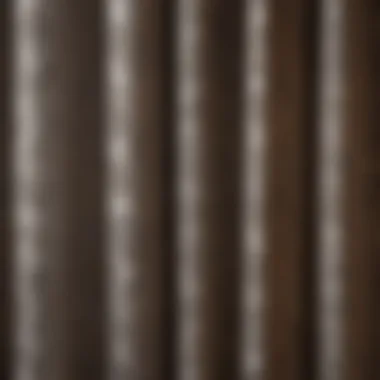The Best Fabric for Bedroom Curtains: An In-Depth Exploration


Intro
Choosing the appropriate fabric for bedroom curtains is more than a matter of personal taste; it's an integral part of creating your desired ambiance while also considering functionality. The selection of curtain fabric influences not just aesthetics, but also factors such as light control, room temperature, and maintenance. This guide will thoroughly explore the nuances surrounding curtain fabrics that best suit various bedroom styles.
Key Insights and Trends
Current trends in interior design
When it comes to current trends, minimalism and sustainability are at the forefront. Homeowners increasingly opt for fabrics that are both visually appealing and eco-friendly. Organic cotton and linen have gained traction for their durability and natural appeal.
Furthermore, the use of darker colors and heavier fabrics for curtains reflects a growing preference for cocooning interiors. Such choices can foster an atmosphere of warmth and retreat.
"Fabrics serve not just as decor but as essential components in achieving comfort and redefining space."
Popular fabric choices
- Cotton: Versatile, easy to maintain, and available in a variety of patterns.
- Linen: Offers a casual elegance and breathability, ideal for lighter tones and open spaces.
- Velvet: Plush and thick, perfect for creating dramatic and luxurious settings.
- Blackout fabrics: Essential for those prioritizing light control. These materials ensure maximum darkness at night, assisting in better sleep.
Practical Tips and How-To Guides
Choosing the right fabric
- Consider the desired ambiance: Lighter fabrics typically open up a room visually, while darker, denser fabrics create intimacy.
- Evaluate light control: Determine if you need sheer fabrics for softer light or heavier materials for total darkness.
- Assess insulation properties: Thick curtains can aid in maintaining room temperature.
Maintenance requirements
- Cotton: Machine washable, but check specific instructions for patterns or prints.
- Linen: Requires more delicate handling and may wrinkle easily.
- Velvet: Should be dry cleaned to preserve its look and feel.
- Blackout curtains: Wipe clean with a damp cloth for longevity.
Selecting the right fabric for bedroom curtains, while often overlooked, is a vital step in enhancing both the functionality and aesthetics of your room. Through understanding current trends and practical guidelines, homeowners can make informed decisions that elevate their living spaces.
Understanding Curtain Fabrics
Selecting the right fabric for bedroom curtains requires a thoughtful approach. The fabric choice greatly influences both functionality and aesthetics. It's essential to understand the nuances of different fabrics to make informed decisions that align with personal taste and practical needs. In this section, we will explore the integral role curtain fabrics play in interior design, along with the most popular types of fabrics used for curtains.
The Role of Fabric in Interior Design
Curtains serve not just as window coverings but also as key design elements that frame the overall look of a room. The choice of fabric impacts light filtering, insulation, and the room's texture. Different fabrics can evoke specific feelings—softness from cotton, elegance from silk, or a more casual vibe from linen. Each type of fabric contributes to the character of a bedroom while complementing the existing decor.
For instance, heavy drapes can create a more formal atmosphere, while lighter fabrics might suit a casual or bohemian style. Understanding how fabric interacts with color schemes and space dimensions is crucial for achieving the desired ambiance.
Popular Types of Curtain Fabrics
When it comes to curtain fabrics, one can explore various options. Here, we dissect the key characteristics and contributions of five popular fabric types:
Cotton
Cotton stands out due to its versatility and ease of care. It is a breathable material, making it suitable for year-round use. The smooth texture of cotton curtains contributes to a soft and inviting atmosphere. Additionally, cotton curtains can be easily washed, making maintenance straightforward. However, they may fade in direct sunlight and require proper lining if used in brighter roles.
Linen
Linen is known for its elegant appearance and natural texture. It adds sophistication to bedroom décor, making it a popular choice among design enthusiasts. The fabric absorbs moisture well, providing a comfortable environment. However, linen does wrinkle easily, which may require regular ironing to maintain its crisp look. Choosing linen for curtains can elevate a room's style but do consider the additional maintenance involved.
Polyester
Polyester is favored for its durability and stain-resistant properties. It can mimic the look of more expensive fabrics while remaining budget-friendly. Polyester curtains are easy to clean and maintain, making them suitable for households with children or pets. However, polyester can trap heat, impacting the bedroom's temperature. It is a practical choice that balances aesthetics with durability.


Silk
Silk exudes luxury and elegance, making it an ideal choice for formal settings. The luster of silk curtains can enhance a bedroom's overall aesthetic, creating a sense of opulence. However, silk is delicate and may require dry cleaning, posing a challenge for everyday use. If you desire a touch of sophistication and are willing to manage the care, silk curtains can be a stunning option.
Wool
Wool is often overlooked but offers excellent insulation properties. It can effectively keep a room warm in winter while also providing noise reduction. Wool fabric can add texture and warmth to the decor. That said, it may not be the best choice for humid climates, as it can absorb moisture. Choosing wool curtains could be a great decision for cooler areas where thermal properties are valued.
With a solid understanding of these fabrics, homeowners can align their curtain choices with their specific needs while enhancing the overall visual and functional appeal of the bedroom.
"Choosing the right fabric for curtains can define the space, combining functionality with style."
Consider the above attributes carefully when evaluating which fabric suits your bedroom best.
Key Factors in Fabric Selection
Choosing the right fabric for bedroom curtains extends beyond mere aesthetics. It is essential to consider various factors to ensure that the curtains serve their intended purpose effectively. Each factor contributes significantly to the overall comfort, efficiency, and design of a space. Understanding these key components transforms a mere curtain selection into an informed decision that enhances both the function and beauty of a bedroom.
Light Control
Light control is perhaps one of the most crucial aspects when selecting curtain fabrics. This element encompasses how much light enters a room and the atmospheric setting that the curtains create.
Sheer vs. Opaque Fabrics
Sheer fabrics allow light to filter softly into the room, creating a bright and airy environment. They work well in spaces where one desires natural illumination without sacrificing privacy. On the other hand, opaque fabrics block light completely, creating a darker and more secluded atmosphere. This is ideal for bedrooms where sleep quality is paramount. While sheer fabrics can provide a breezy feel, they might not offer enough privacy for all settings.
Light Filtering Properties
Light filtering properties amplify the ability of a fabric to moderate the amount of sunlight entering a room. Fabrics with light-filtering abilities strike a balance between sheer and opaque choices. They provide soft illumination while ensuring that privacy is not compromised. Choosing fabrics with these properties can enhance comfort by reducing glare and providing a soothing light quality.
Insulation and Thermal Properties
The insulation and thermal properties of curtain fabrics significantly impact energy efficiency and comfort levels in a bedroom. Appropriate choices can contribute to keeping a space warm in winter and cool during summer.
Energy Efficiency
Energy-efficient fabrics can dramatically decrease heat loss during colder months. Such fabrics often have a thermal lining that acts as a barrier against cold air, thus lowering heating expenses. This is particularly beneficial for those living in regions with extreme weather conditions. However, thicker fabrics may feel heavier and might not suit every design preference.
Noise Reduction
Noise reduction is another aspect to consider, especially in urban settings or busy households. Certain fabrics provide sound-absorbing qualities, which help to diminish external noise disturbances. This contributes to a peaceful sleeping environment. While effective for noise reduction, heavier fabrics might be more challenging to maintain and can require thoughtful pairing with lighter elements in the room.
Durability and Maintenance
Durability and maintenance are critical components that can dictate how long the fabric lasts and how much effort it requires to keep it looking fresh and new.
Stain Resistance
Stain-resistant fabrics are particularly advantageous in environments with children or pets. These fabrics repel spills and are easier to clean. As a result, they maintain a pristine appearance longer than non-treated alternatives. However, some stain-resistant treatments might affect the fabric's texture or breathability.
Washability
Washability is a practical concern for most homeowners. Fabrics that can withstand regular washing ensure longevity and ease of maintenance. Choosing fabrics that can be machine washed rather than dry-cleaned could save time and cost in the long run. However, frequent washing may lead to fading or wear over time, so considering the right care instructions is important.
Design Considerations


Choosing the right fabric for bedroom curtains is not just about aesthetics; it plays a significant role in the overall atmosphere of the room. Design considerations encompass various elements including style, color, and texture, all of which can significantly influence how a space feels and functions. By understanding these factors, one can select fabrics that align with personal preferences and the existing decor.
Matching Fabrics to Bedroom Styles
Contemporary
In contemporary design, simplicity is key. The focus is often on clean lines and minimalism. Curtains made from lightweight fabrics like sheer polyester or cotton fit seamlessly into this style. They offer a sense of openness and lightness, which is essential in modern homes where functionality meets aesthetics. The key characteristic here is versatility; contemporary fabrics can easily adapt to changing trends without overwhelming the space. However, a disadvantage can be their lack of insulation, which may require added layers during colder months.
Traditional
Traditional bedroom styles emphasize warmth and richness. Fabrics like heavy drapes in velvet or brocade serve this purpose well. They add a luxurious touch and a sense of history to the room. The prominent feature of traditional curtains is their ability to evoke nostalgia, making the space feel inviting and cozy. This type of fabric is beneficial for its excellent light-blocking capabilities, but they can also require more maintenance due to their heavier nature and fabric type.
Bohemian
Bohemian decor is all about personal expression and eclecticism. Fabrics that embody this style often include colorful patterns, tassels, and varied textures. Choosing bold, vibrant cotton or linen can heighten visual interest. The key characteristic of Bohemian curtains is their ability to tell a story, showcasing an individual’s taste and travels. While these fabrics can bring life to a bedroom, their chaotic patterns might not appeal to those who prefer a more streamlined look.
Color Schemes and Patterns
Solid Colors
Solid color curtains provide a clean and unobtrusive appearance that can either blend with or contrast against the existing decor. They are adaptable and can complement various themes, from calming neutrals to vibrant shades. The benefit of solid colors is their timelessness; they do not go out of style and are easy to change with new accents or furnishings. However, they can appear too plain or stark if not balanced with other design elements.
Patterns and Textures
Choosing patterned or textured fabric adds depth and character to bedroom curtains. Patterns can range from floral to geometric, while textures may include woven or embroidered fabrics. This approach allows for creative expression and can become a focal point in the room. Patterns in curtain fabrics are popular for their visual interest, yet they can overwhelm a space if used excessively. Balancing patterns with simpler elements in the room is crucial for achieving harmony.
Understanding design considerations is about more than just look; it sees how fabric choices influence mood and function in the bedroom.
Sustainable Fabric Options
Choosing sustainable fabric options for bedroom curtains is becoming increasingly relevant in today’s context. Environmentally friendly materials not only reduce our carbon footprint but also contribute to healthier living spaces. As awareness of environmental issues grows, more homeowners and designers are considering how their choices impact the planet. Sustainable fabrics offer an elegant solution that aligns aesthetic preferences with Eco-consciousness.
Eco-friendly Fabrics Overview
Bamboo
Bamboo is an impressive sustainable fabric due to its rapid growth and minimal resource requirements. It can thrive in diverse conditions without the need for pesticides or fertilizers. The softness and natural sheen of bamboo fabric make it appealing for bedroom curtains. Importantly, bamboo is biodegradable, reducing waste when the curtains reach the end of their life cycle. However, one must be cautious as not all bamboo fabrics are created equal. The manufacturing process can involve chemicals that may not be environmentally friendly. Thus, selecting bamboo that is processed in a safe manner is essential.
Organic Cotton
Organic cotton is another leading choice in sustainable fabrics. It eliminates harmful pesticides and synthetic fertilizers, making it a healthier option for both users and the environment. Its breathability and softness are notable traits, allowing for comfortable bedroom curtains. The unique feature of organic cotton is its versatility; it can easily blend with various interior styles. However, its production can be more labor-intensive and expensive compared to conventional cotton, which may affect its market availability.
Recycled Materials
Using recycled materials in curtain fabrics summarizes a proactive approach in sustainability. These materials often come from post-consumer products, giving a second life to what would otherwise be waste. The key characteristic of recycled fabrics is their potential to reduce landfill waste and lower the demand for virgin materials. This choice also often involves lower energy consumption during production. Still, the challenge is ensuring the quality and durability of the resulting fabric, as not all recycled materials maintain their integrity.
The Impact of Sustainable Choices
The impact of selecting sustainable fabrics extends beyond aesthetic considerations. Opting for these materials fosters a culture of responsibility toward our environmental footprint. They often provide health benefits too, as natural and organic fabrics reduce exposure to harmful chemicals. Furthermore, incorporating sustainable options can inspire a shift in consumer habits, encouraging others to make informed choices.
Timely decisions about fabric could ultimately lead to a significant positive change in the textile industry. Sustainable fabrics serve as a path toward more ethical and Eco-friendly living, showcasing that beauty and function can harmoniously coexist in our homes.
Expert Tips for Choosing Curtain Fabrics
Choosing the right fabric for bedroom curtains is both an art and a science. Tips from experts can significantly streamline the selection process, ensuring that the chosen fabrics align with the intended function, style, and design of the space. This section delves into critical aspects that homeowners and design enthusiasts must consider before making a final decision. Understanding personal needs in combination with practical testing of fabric can result in a tailored solution that is both aesthetically pleasing and functional.


Assessing Your Needs
Before diving into fabric options, it is essential to assess your needs comprehensively. Consider the purpose of the curtains. Are they primarily for light control, privacy, or decor? Different fabrics offer varying levels of opacity and insulation, which can influence comfort in the bedroom. Think about the window size as well. Larger windows may require heavier fabrics to maintain a cohesive look without overwhelming the space.
Additionally, you must consider the climate of your area. In warmer climates, breathable fabrics like linen or cotton can help keep the room cool. For colder regions, heavier options such as wool or blackout polyester can provide warmth and insulation. Moreover, personal lifestyle choices play a role. If you have pets or children, fabrics with stain resistance and durability are beneficial. Recognizing these factors early ensures that the chosen curtains meet your specific demands effectively.
Testing Fabrics
When selecting curtain fabrics, testing is crucial. This process allows you to ascertain how various fabrics will interact with your bedroom's specific conditions such as light and temperature.
Swatch Samples
Swatch samples are an important element in this testing phase. They enable you to see and feel the fabric in your own home environment. Key characteristics of swatch samples include their ability to highlight texture, color, and weight. This is particularly beneficial because you can assess how the fabric will drape and behave under different light. One unique feature of swatch samples is the opportunity to match them against existing decor. This helps in visualizing the overall look before making a purchase.
However, relying solely on swatches has its disadvantages. Sometimes, colors can appear differently in varied lighting conditions. Thus, it is advisable to view samples at different times of the day to get an accurate sense of how the fabric will look.
Visible Light Test
Another effective method for evaluating curtain fabrics is the visible light test. This involves holding the fabric up to a light source to observe its light-filtering properties. The key characteristic of a visible light test is its ability to reveal how much light will penetrate the fabric when hung. This is particularly beneficial for those looking to achieve specific lighting conditions in their bedroom, whether it is a bright and airy atmosphere or a cozy, dark environment.
A unique feature of this testing method is that it also allows you to see any sheerness or opacity clearly. However, limitations exist; some fabrics may look different in natural light than in artificial light. Be mindful of this as you evaluate options.
"Choosing the right fabric goes beyond aesthetics; it’s about how that fabric impacts your daily life in terms of light, comfort, and usability."
Where to Purchase Quality Curtain Fabrics
Choosing where to buy quality curtain fabrics significantly impacts both the look and feel of your bedroom space. The right fabric enhances not only aesthetics but also functionality, considering factors such as durability and maintenance. Sourcing from reputable suppliers ensures that you receive products that meet your needs and expectations.
This section outlines two primary purchasing avenues: online retailers and local fabric stores. Each option has its own benefits and considerations, depending on your preferences and requirements.
Online Retailers
Online shopping provides a convenient way to access a vast array of fabrics from the comfort of your home. Many online retailers specialize in curtain fabrics, allowing for easy comparison of patterns, colors, and materials. Here are some key advantages of buying fabric online:
- Variety: Online platforms often feature a wider selection of fabrics than local shops. Customers can explore diverse styles from various brands without geographical limitations.
- Competitive Pricing: Online retailers often have lower overhead costs, which can translate into better prices for customers.
- User Reviews: Many websites include customer reviews and ratings, giving insights into fabric quality and practicality. This information can lead to more informed decisions.
- Convenience: Shopping online means you can browse late at night or fit buying into your busy schedule. Many retailers also offer delivery to your door, simplifying the whole process.
Notable online retailers that offer high-quality curtain fabrics include sites like Fabric.com, Joann, and Amazon. They typically have a dedicated section for curtain materials, making it easier to navigate options.
Local Fabric Stores
Contrarily, local fabric stores offer a tactile shopping experience that can be invaluable. Visiting a store allows you to touch and feel the fabric, assessing its texture and weight. Here are some merits of opting for local fabric stores:
- Direct Interaction: Customers can speak to knowledgeable staff. They can provide recommendations based on your needs and preferences, offering a personal touch to the shopping experience.
- Immediate Availability: Buying locally means you get the fabric right away without waiting for shipping, which can be essential for time-sensitive projects.
- Supporting Local Economy: Purchasing from local stores supports your community and local businesses, which is a notable factor for many conscientious buyers.
- Fabric Samples: Many local stores provide swatch samples that allow customers to test how the fabric looks in their space before making a purchase.
Some reputable local fabric stores include your local G Street Fabrics or independent shops in your area. They often carry unique selections you might not find online, allowing for greater personalization in your curtain designs.
In summary, whether you choose online retailers or local fabric stores, understanding the strengths of each option can optimize your experience and result in choosing the best materials for your bedroom curtains.
End
In any discussion of bedroom curtains, the conclusion serves to encapsulate the essential elements explored throughout the article. Selecting the best fabric for bedroom curtains has significant ramifications for both the functionality and aesthetic of the space. It requires careful consideration of various factors that influence not only the appearance of the curtains but also their effectiveness in controlling light, providing insulation, and enhancing privacy.
Summarizing Key Insights
Throughout this article, various key insights emerged regarding the selection of fabric for bedroom curtains. The type of fabric significantly influences light control, from the sheer delicacy of linen to the opacity of heavier materials such as wool or silk. For instance, sheer fabrics allow ambient light to filter in, creating a soft glow perfect for relaxed settings, while opaque fabrics help block intrusive sunlight, crucial for better sleep quality.
Additional important insights include the thermal properties of fabric. Curtains can serve to insulate a bedroom, thereby impacting energy efficiency by helping to regulate indoor temperatures. This is particularly useful for those looking to reduce heating or cooling costs.
Durability and maintenance also play vital roles. Fabrics like polyester and cotton offer ease of care, whereas silk may require more delicate handling. Understanding these characteristics can lead to a more informed choice that aligns with your lifestyle.
Encouragement for Informed Choices
Finally, homeowners and design enthusiasts are encouraged to approach fabric selection with mindfulness and knowledge. Being informed about the various fabric types, their properties, and suitability for your specific needs can transform a simple purchase into a strategic design decision.



